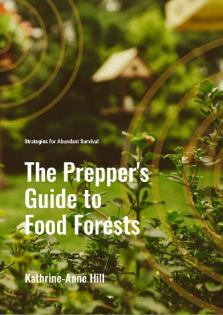DIY Wilderness Tools: Crafting Essential Gear from Nature
Discover essential DIY wilderness tools that can make all the difference in a survival situation. Whether you're an outdoor enthusiast or a seasoned prepper, mastering these skills will enhance your self-reliance and preparedness in the wild. Learn step-by-step techniques, including how to find and use materials that are readily available in nature.
SURVIVAL POSTS
Kathrine-Anne Hill
10/14/20246 min read


Affiliate Disclosure:
Please note that some of the links in this article are affiliate links. This means that if you click on these links and make a purchase, I may receive a small commission at no additional cost to you. This commission helps support the maintenance and growth of this website and allows me to continue providing valuable information and recommendations. Rest assured, I only recommend products and services that I have personally used or thoroughly researched. Your support is greatly appreciated! “As an Amazon Associate I earn from qualifying purchases.” For full disclosure see our Privacy Policy and Terms and Conditions here.
Introduction to DIY Wilderness Tools
The idea behind DIY wilderness tools is all about making essential gear from materials found in nature. This practice encourages self-sufficiency and helps develop crucial survival skills that are important in outdoor situations. By creating your own tools, you can strengthen your bond with the environment, gaining a deeper appreciation for the resources nature provides and learning how to use them effectively.
Making tools like spears, fishing hooks, and digging sticks requires a good understanding of the natural world and what it offers. These tools are not just practical; they emerge from a creative process that showcases the maker's resourcefulness and creativity. When you take on the task of crafting your own wilderness tools, you shift from being just a consumer of gear to becoming a creator, forming a unique connection with the materials you work with.
One of the main advantages of making your own wilderness tools is the heightened level of preparedness it brings. In unfamiliar or survival situations, knowing how to build tools can be the key to success. Additionally, the experience of crafting these items from scratch fosters a sense of achievement that you won't find with store-bought gear. This creative process encourages problem-solving skills, patience, and a proactive attitude, all of which are essential in the wilderness.
As we look into different types of DIY wilderness tools in this post, we will explore step-by-step methods for crafting each item, detailing the materials needed and the techniques to use. The skill of making things by hand is not only practical; it’s a rewarding experience that connects us to our environment and enriches our outdoor adventures.
Crafting A Spear from Natural Materials
Creating a spear from natural materials is a vital skill that can boost your chances of survival in the wild. To begin, it's important to choose the right type of wood. Straight, sturdy branches from trees like willow, ash, or hickory are ideal. These types of wood are not only strong but also flexible, which helps during both the crafting process and the spear's performance.
Start by looking for a straight branch that is about six to eight feet long, as this length provides better control and reach. Check the branch for any knots or bends that might compromise the spear's strength. Once you find a suitable branch, use a knife or a sharp stone to remove the bark, exposing the wood underneath. This step helps you spot any flaws in the branch and improves your grip.
Next, you'll want to sharpen the tip. You can do this by whittling the end of the branch to a point, ensuring the spear is effective. For a more robust spear tip, consider using a stone or another sharp object. Choose a medium-sized stone with a pointed edge, and carefully chip away at its surface to form a sharp tip. You can attach the tip using natural cordage or by making small notches at the base for a secure fit.
Safety should always come first when crafting your spear. Wear protective gear when needed, especially when handling sharp tools. After your spear is complete, practice your throwing techniques in a safe area to ensure you have control and accuracy. It's wise to get accustomed to the spear’s balance and weight, as this will greatly enhance your effectiveness in a wilderness environment.
Creating Fishing Hooks from Nature
Crafting fishing hooks from natural materials is a valuable skill that showcases the creativity of DIY wilderness enthusiasts. The variety of resources available allows for the creation of effective hooks, using items like fish bones, sharp twigs, or discarded wires. Each of these materials can produce unique hook designs suited to different fishing environments.
To start, find the right materials. Fish bones, especially from larger species, can be shaped into functional hooks. Be sure to clean and dry the bones thoroughly for better durability. If you prefer wooden hooks, look for strong, flexible twigs that are relatively straight. They should be sturdy enough to handle the tension while fishing but not too thick. Alternatively, thin wire from discarded items can be cut into lengths and bent into hook shapes.
After gathering your materials, the next step is to shape the hook. For fish bone hooks, use a knife to carve the bone into an elongated form with a pointed end, mimicking a traditional hook. For wooden hooks, whittle the chosen twig to create a hook shape at one end, leaving enough length for attaching the fishing line. With wire, simply bend the piece into a hook shape and make a small loop for the line attachment.
Attaching a fishing line is simple. Use strong natural fiber, such as plant sinew, to secure the line to the hook, making sure to tie a tight knot for stability during use. When you're ready to fish, consider effective techniques by casting in areas with high fish activity and practicing patience while waiting for a catch.
While fishing, it's important to respect nature by adhering to local regulations and practicing catch-and-release strategies when appropriate. Prioritizing safety during your outdoor adventure not only ensures a rewarding experience but also protects the surrounding environment.
Making Digging Sticks for Foraging and Survival
Crafting effective digging sticks from natural materials is a valuable skill that can greatly enhance your foraging and survival experiences. To make a digging stick, start by choosing the right type of wood. Look for sturdy yet lightweight options like oak, ash, or maple, which offer the necessary durability without being too heavy. The quality of the wood is important; it should be strong enough to handle the pressure of digging into the ground.
When deciding on the right length and thickness for your digging stick, think about your height and comfort. A practical digging stick typically measures between two to three feet long, providing enough leverage without causing too much strain. A diameter of about one to two inches usually offers a good grip while keeping it light enough for prolonged use.
To shape the stick for better digging performance, consider tapering one end to form a pointed tip. You can do this through carving or whittling, which makes it easier to penetrate the soil. A well-crafted digging stick can help you find edible roots, tubers, or other food sources hidden beneath the earth's surface. Additionally, digging sticks can be useful for various survival tasks, such as building shelters or collecting materials for a fire.
When using digging sticks, it's crucial to prioritize safety. Always stay aware of your surroundings and the potential for injuries while digging. Practicing ethical foraging is also essential; this means only taking what you need and ensuring the ecosystem remains balanced. By properly crafting and using a digging stick, you can significantly enhance your foraging skills while respecting nature.








The Prepper's Guide to Food Forests: Strategies for Abundant Survival is a concise, step-by-step guide to creating a self-sustaining food forest. Ideal for preppers, it covers essential topics like design, plant selection, permaculture, companion planting, and wildlife integration. Learn how to maintain your forest, boost yields, and make it part of your survival strategy.
Highlights:
Basics of food forests and their benefits
Designing and selecting resilient plants
Creating a self-sustaining ecosystem
Using permaculture and companion planting
Maintenance, harvesting, and wildlife habitats
Food forests as part of a prepper strategy
Perfect for anyone seeking long-term food security.
Sign-Up and receive my FREE eBook The Prepper's Guide to Food Forests: Strategies for Abundant Survival !
As always, be sure to check our website for more wilderness tips and gear updates!
